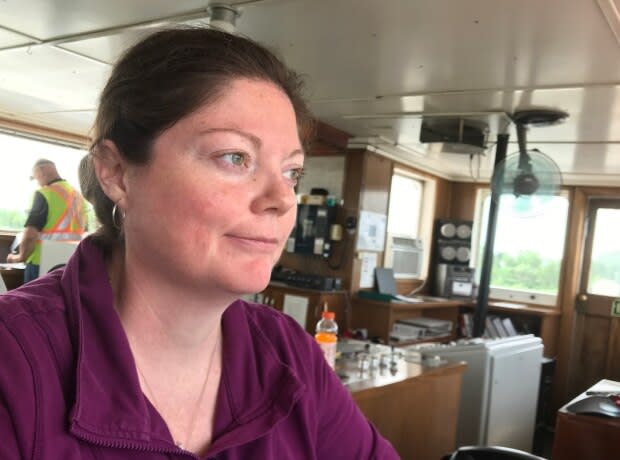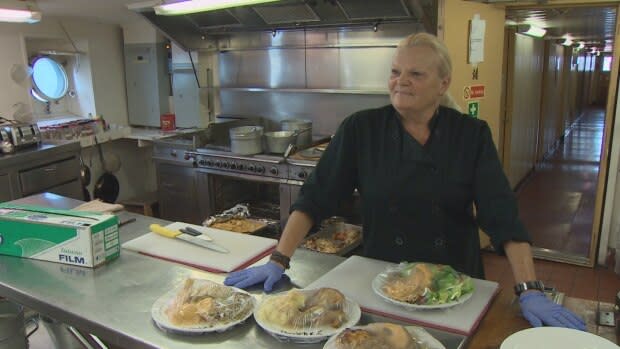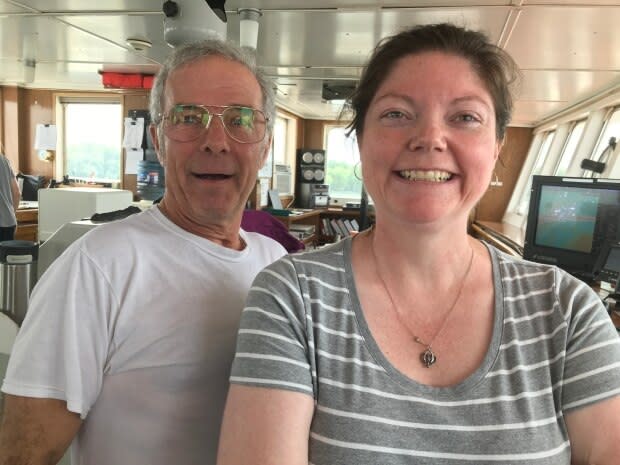Plotting her own course: Meet the Newfoundland captain navigating her way in a man's world
It's late July and a massive ship is squeezing through the St. Lambert Lock in Montreal.
The length of nearly four hockey rinks, the Tim S. Dool is a familiar sight in the St. Lawrence Seaway.
The ship is built to navigate the Great Lakes, canals, and a network of locks that gradually lift vessels like this more than 180 metres above sea level.

Once inside the lock on Montreal's South Shore, the doors are closed and 90 million litres of water is pumped in.
Within minutes, the Dool rises 4½ metres, and slowly carries on to the next lock.
Reaching the heart of North America
It's a process repeated many times before the Dool reaches the Great Lakes, and the heart of North America.
It's an amazing feat of engineering, but it's so common around here that it barely solicits a second glance from passersby.
There's something unique about the Dool on this day, however. You need to look to the bridge, high inside the large white superstructure near the stern of the ship.

From a distance, behind a row of windows, you can see a silhouette of a person, hair pulled into a ponytail.
Meet Capt. Charlene Munden, senior officer on board the Dool.
She's from outport Newfoundland, and is making her way — quite literally — in a man's world.
"Right now we've got 20 on board. There are three women — the rest are men — [and] the other two are cooks," Munden says as she greets her two guests, a CBC News crew that will follow her for the next two days.
They call her Cap, or ma'am
Her gender is not the only thing that sets her apart in this industry.
Her crew calls her Cap, or ma'am, and since Oct. 6, she's added another title: mother. But more on that later.

On this voyage, Charlene is six months pregnant.
"They're all treating me like they're all dads now," she says of the crew. "They're taking good care of me here."
Ships like the Dool deliver the commodities that help keep North America's economy humming, and on this day is weighed down with more than 27,000 tonnes of iron ore pellets from the Labrador Trough.

It's making its way from Port Cartier, in the Gulf of St. Lawrence, to a steel factory in Hamilton.
The ship is not home, but for Charlene, it's the next best thing.
"I think it suits my personality," she says. "I'm not a big people person."
She's a rare find
Dozens of Canadian-flagged bulk carriers navigate the Great Lakes, but you could seat all the female captains inside a compact car — and still have room for another passenger.

She's an inspiration to the few other women on board.
"She's bringing [women] way forward into the future," says Paula Morley, a native Cape Bretoner who has worked 32 years on the Great Lakes.
Morley, the chief cook on the Dool, knows how difficult it can be for a woman to work in the shipping industry.
It wasn't long ago that she would discourage it because it was "pretty rough." Not anymore.
"There's a lot of protection for women out here now. Nowadays the men have finally started to realize that it's unacceptable."
Women are in demand
Women like Munden and Morley comprise just two per cent of the world's 1.2 million seafarers.
So the industry is trying to bridge that gender gap.
"We've got a lot of work to do to drive more awareness, to continuously adapt and adopt our practices to better suit women," says Chamber of Marine Commerce president Bruce Burrows.
The shipping industry is desperate for workers, with vacancies in every specialty. And companies want to attract more women to help fill the void.
"I think tradition is a bit of a barrier," Burrows adds. "It is an industry that has traditionally attracted men. Add sometimes men haven't been as accommodating in the workplace to accept women."
'It was difficult at times'
Munden experienced that early in her career, and some of her male colleagues didn't take her seriously.
"I was always the baby on board and they treated me as such sometimes," she says. "And then being most of the time the only female on board they're always saying, 'Don't do that or don't lift this, you're a girl.' But of course then I had to prove them wrong and do it anyway."
Now, Munden is the gold standard for a movement to draw more women into the shipping industry. She's under 40, highly trained and respected by her fellow sailors.

"[I'm] amazed to see her experience around the docks," says Jean Bouffard, the second mate on the Dool, who has sailed these waters since 1976.
Bouffard has watched the industry evolve from a time when some believed an old nautical superstition that it was bad luck to have women on board, to an era where he's answering to one.
He speaks in glowing terms about his captain's abilities as a mariner. "If I work with her, I'm happy," he says.
We're in dire need of every officer. Doesn't matter if it's male or female. Someone has soon got to do something or the cargo is not going to move. - Capt. Charlene Munden
Munden is eager to tout the benefits of her job — good salary, ongoing training, career advancement and more — because she sees a day when the lack of experienced mariners could become critical.
"We're in dire need of every officer. Doesn't matter if it's male or female," she says. "Someone has soon got to do something or the cargo is not going to move."

Industry leaders want to address that shortage by recruiting more people like Munden.
Shorter shifts at sea, and more flexibility for those trying to balance work and family, are some of the changes.
A tiny harbour, not on the shipping lanes
But to really tell the story of Charlene Munden, you have to travel to where it all started: tiny Jean de Baie, on Newfoundland's Burin Peninsula.
It's early February, and winter ice has closed the Great Lakes to shipping. The biggest boat in Jean de Baie would be lost in the cargo hold of the Dool.
Charlene lives in a modern home with her husband, Mark Munden. And right next door? The house where she grew up with her parents, Ron and Regina Coady, and older brother Tim.
"I'm proud of her. I'm glad she went and done what she did," says Regina.

Charlene studied at Marine Institute in St. John's, served seven years as a first mate, and was promoted to captain two years ago.
"For not knowing what I was getting myself into, I think I chose something that was pretty right for me. I don't think I can see myself at anything else," she says.
'Aye aye, Capt. Girly'
And when Charlene was promoted to captain, her playful father changed the way he addressed his daughter.
He begins each phone call by saying "Aye aye, Capt. Girly."
"She is after doing something amazing," says Ron Coady.
In Newfoundland and Labrador, it's far from uncommon for one spouse to leave the province for work over long stretches of time.
But the roles are reversed from the typical scenario. While Charlene heads away, Mark works close to home, at a grocery store in Marystown.
Quiet time on the bridge
Back on the Dool, another hot July day is coming to an end, with Capt. Munden — noticeably pregnant — enjoying some quiet time on the bridge.
She's balancing her work demands with the thoughts of the small child growing inside her.

"It's a long time coming so we're both excited," she says.
In the distance, the sun is setting over Toronto, offering up a peaceful scene from a vantage point that few are able to enjoy.
Welcome James
A little over two months later, a new day dawns for the Munden family, with the birth of a baby boy.
James Coady Munden was born just before 8 a.m. on Oct. 6, and pretty soon, he'll probably find himself travelling the Great Lakes at his mother's side.

"I think I'm going to bring him out when I can and have him on board with me," she says during a recent visit to her Jean de Baie home.
"If he wants to be a sailor, he can be. If not, well, he can be whatever he wants to be."
That makes sense.
After all, that's precisely what his mom did.
See the documentary profiling Capt. Charlene Munden on Here & Now on Monday evening or hear it on CBC Radio's morning shows provincewide Monday morning.
Read more from CBC Newfoundland and Labrador

